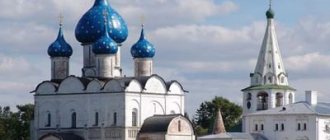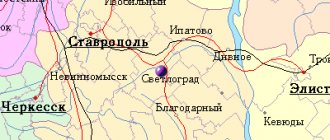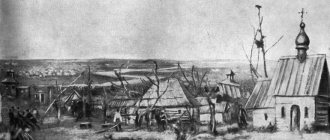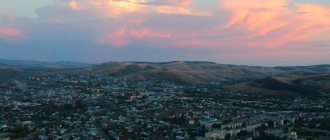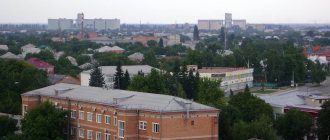The Rostov region is located in the southern part of the East European Plain and partly in the North Caucasus region, occupying a vast territory in the Lower Don river basin. The area of the region is 100.9 thousand km² (0.6% of the territory of Russia). It could accommodate Belgium, Holland and Denmark combined. The length of the region is 470 km from north to south, 455 km from west to east.
In the west, the border of the Rostov region coincides with the state border of the Russian Federation with the Republic of Ukraine, including the maritime border in the Taganrog Bay of the Sea of Azov. In general, the length of the border of the Rostov region with Ukraine is about 700 km. Currently there are 22 customs checkpoints here.
In the north, east and south, the Rostov region borders on the constituent entities of the Russian Federation - the Voronezh and Volgograd regions, the Republic of Kalmykia, the Stavropol and Krasnodar territories.
The region is located within the North Caucasus economic region of Russia. Its immediate surroundings are represented by highly developed economically regions: Donbass in the west, Central Russia in the north, the Volga region in the east and the Caucasus in the south. Within a radius of 1.0 - 1.5 thousand km from the borders of the Rostov region are the country's largest coal, oil, gas, metallurgical, engineering, chemical, agro-industrial regions and centers.
The Rostov region includes 463 municipalities, consisting of 12 urban districts, 43 municipal districts, 18 urban settlements and 390 rural settlements. The administrative center of the Rostov region is the city of Rostov-on-Don with a population of over 1 million people, a large industrial, cultural and scientific center. In 2002, the city acquired additional political and economic importance as the capital of the Southern Federal District. The distance from Rostov-on-Don to Moscow is 1226 km.
The major cities of the region are Taganrog (population 281 thousand people), Shakhty (245.5 thousand people), Novocherkassk (173.3 thousand people), Volgodonsk (169.6 thousand people) and Novoshakhtinsk (113 ,6 thousand people), Bataysk (104.8 thousand people).
Center coordinates.
We determine the geographic center of our region in geography lessons in 8th grade. It's very easy to do! To do this, you need to know the coordinates of the extreme points of the territory. In the Rostov region they are as follows:
The extreme northern point is located in the Verkhnedonsky region and has coordinates - 50.13, N.Sh.
The southernmost point is located in the Peschanokopsky district and has coordinates - 45.57, N.Sh.
The westernmost point is located in the Matveevo-Kurgan region and has coordinates - 38.14, E.D.
The easternmost point is located in the Zavetinsky district and has coordinates - 44.20, E.D.
To determine the geographic center, you need to calculate latitude and longitude.
50.13,+45.57,= 96.10,
96.10,: 2 = 48.05 (this is the latitude of the geographic center)
38.14,+ 44.20 = 82.34,
82.34, : 2 = 41.17, (this is the longitude of the geographic center)
Thus, the coordinates of the geographic center are 48.05, N.Sh., 41.17, E.D.
Brief description of the Rostov region
The Rostov region is a subject of the Russian Federation in the south of the European part of Russia, part of the Southern Federal District.
The Rostov region, as an administrative unit, was formed on the basis of a resolution of the Central Executive Committee of the USSR dated September 13, 1937.
Among other large territorial entities of the Russian Federation, the region stands out for its high scientific, production, resource and financial potential.
The development of the region's economy is based on the influence of such factors as a favorable economic and geographical position (connection of the center of Russia with the North Caucasus and Transcaucasia), the presence of natural resources, historically favorable development conditions, a high supply of labor resources, and a well-developed transport infrastructure. In terms of the pace of economic transformation in recent years and the volume of output of goods and services, the region occupies one of the leading positions both in the Southern Federal District and in Russia as a whole.
The immediate surroundings of the region are represented by the regions of Western Donbass, which have large reserves of natural resources, as well as the highly economically developed regions of the central part of Russia in the north, the Volga region in the east and the North Caucasus in the south.
Within a radius of 1.0-1.5 thousand km from the borders of the Rostov region there are the country's largest coal, oil, gas, metallurgical, engineering, chemical, agro-industrial areas and centers, the exchange of finished products of which is carried out, to a large extent, through the territory of the Rostov region. areas.
The Don, one of the largest rivers in Europe, with numerous branches and tributaries, flows through the region.
Mineral raw materials include a group of fuel and energy resources. Among them are coals from Eastern Donbass, especially anthracite, which is the best in the world in terms of caloric content.
Deposits of nonmetallic raw materials for metallurgy and the production of building materials are being developed. Explored gas reserves are estimated at 56.2 billion cubic meters.
The forest fund of the region is insignificant, represented on 2.8% of the territory, mostly by forests that perform water protection and protective functions.
Recreational resources are represented by local resorts for summer holidays with reserves of high-quality mineral waters, as well as ample opportunities for the development of international tourism.
Geographical location of the Center.
The geographical center of the Rostov region is located on the territory of the Tatsinsky district. Nearby are the villages: Isaev, Fominka, the village of Ermakovskaya - Tatsinsky district and the village of Yasnov - Belokalitvinsky district. The figure shows that the geographical center is located, practically, on the border of these two territories. If we calculate the straight line distance to the administrative centers, we get the following results: to Belaya Kalitva - about 35 kilometers, to Tatsinskaya - about 25 kilometers. Therefore, the route to the geographical center should be considered in the territory of two regions.
48.05, 41.17, Geographical center of the Rostov region.
Option No. 2
The Rostov region occupies more than a hundred thousand square kilometers on the shores of the Taganrog Bay of the Sea of Azov. The bay is named after the second largest city in the region, Taganrog, where the wonderful Russian writer Anton Pavlovich Chekhov was born. In total, there are eleven cities on the map of the region with a population of more than 50 thousand people. The Rostov region borders on Ukraine, Volgograd and Voronezh regions; from the south its neighbors are the Stavropol Territory and the Krasnodar Territory; Kalmykia in the southeast. Part of the region's territory belongs to Asia.
Recently, the population of the Rostov region has been decreasing. Today, approximately 4.2 million people of more than twenty different nationalities live here. The majority of the population (90%) are Russians. Such a diversity of peoples is often found in the south of Russia. In ancient Maeotis, people who came from different places settled. They created an amazing cultural heritage.
Archaeologists have found an amazing vessel of the 1st century BC in the city of Azov. in the shape of a ball. It is the largest alchemical object found in Eastern Europe. The furnace for smelting metal dates back to the 1st century AD. Almost two thousand years ago, people living in these parts already knew how to make tools and weapons from metal. Right in the city, living a modern life, a group of the richest burials from around the 2nd century AD was discovered, in which various vessels, tools, and parts of jewelry were found. There was another very rare find - an entire jewelry workshop with tools, blanks and jewelry parts.
Almost everywhere here is flat steppe. The highest point (253 meters) is located in the Donetsk Ridge. The main river is the majestic Don, which has long been respectfully nicknamed “father”. There are few forests and lakes here, but the flora and fauna are very diverse, especially in the north-west.
The Rostov region is an important industrial region. There are dozens of metallurgical, engineering, and oil refineries operating here. The largest of them is the Taganrog Metallurgical Plant, which produces welded and seamless pipes of very large diameters.
2nd, 4th grade, 3rd, 5th, 8th, 9th grade. Geography
Creating a route.
Having calculated the geographical center and examined the territory, we came to the conclusion that several tourist routes can be created in the Tatsinsky and Belokalitvinsky districts. Let's call it figuratively:
- Historical (route passing through historical places of the territory).
- Natural (route passing through unique natural sites).
- Recreational (route passing through recreation areas).
After much debate and discussion about which one would be more interesting and visited, we decided to hold a sociocultural workshop. To do this, we compiled a questionnaire and asked people we knew and didn’t know, living in the Rostov region and beyond, to fill it out. The results were as follows:
10% prefer to travel to historical places.
17% - like to visit interesting natural sites.
25% prefer recreational areas.
48% try to combine business with pleasure, since it is not always possible to choose the time and find the means to travel.
Therefore, we decided to create a route that will be interesting and useful, in which pages of history will be intertwined with the extraordinary beauty of the nature of the Don region, in which there will be time for relaxation and communication, learning new and interesting things, time to be alone with yourself.
Religions
There are up to 500 religious organizations of 33 faiths operating here. The majority consider themselves Orthodox Christians or atheists. But there are also numerous parishes of the Armenian Apostolic, Lutheran, Baptist, Catholic, Protestant churches, there are Muslim and Jewish communities, organizations of evangelists and Adventists.
A large number of religious monuments have been preserved in the region. On the map of attractions of the Rostov region you can easily find real masterpieces of religious architecture. These are such pearls as the Ascension Military Cathedral in Novocherkassk, the Soldiers' Synagogue and the Armenian Church of Surb Khach, the temples of the Sovereign Icon of the Mother of God in the center of Donetsk and St. Nicholas the Wonderworker in the village of Nikolaevka, Neklinovsky district, Rostov region and many others. Recently, several mosques have been built.
Informational resources:
- Literature:
- Belaya Kalitva 300 years (publication of the Belaya Kalitva city administration). 2003
- Materials from the newspaper "Crossroads"
- Stepanenko L.G. Rostov region: Geographical descriptions of nature. Rostov-on-Don.2005
- Internet resources:
- Belokalitvinsky district[1]
- Educational portal about the Don region “Don Dawns”.[2]
- Kalitva.ru.[3]
- Official portal of the Administration of the Rostov region[4]
- Patriotic Internet project “Heroes of the Country.”[5][6]
- Wikipedia[7][8]
- Netrebsky V.P.[9].
Marriages and divorces
Detailed official statistics on registration and divorce of marriages suggest that the picture reflects nationwide trends. The number of newly created families for 2022 is 20,935, which is 20% less than in the previous period.
79% of registered marriages are dissolved. The number of divorces in 2020 decreased by 8%, but remains critical. Divorce statistics in cities are worse than in rural areas. The age of people getting married is growing, young people prefer informal relationships.
The Rostov region broke the record for the number of coronavirus cases per day
Today, January 21, the Rostov region broke the record for the number of people infected with coronavirus. Over the past 24 hours, 699 cases have been identified in the region. It also became known that nine patients with a confirmed diagnosis died. The latest data was published by the press service of the regional government.
New infections appeared in 55 cities and districts of the region. Thus, the Don capital still leads in the number of cases - 222 people were infected with the coronavirus here. In Taganrog, 37 infected people were identified. In Volgodonsk - 32. In Bataysk - 29. In Shakhty - 27. In Aksaisky district - 26. In Novocherkassk - 24. In Salsky district - 23. In Azov - 19. In Azov district - 16. In Gukovo - 15. In Kamensk -Shakhtinsky and Zernogradsky districts - 14 each. In Novoshakhtinsk and Oktyabrsky district - 11 each. In Belokalitvinsky, Krasnosulinsky, Matveevo-Kurgansky, Myasnikovsky and Neklinovsky districts - 10 each. In Egorlyksky and Millerovsky districts - seven each. In Zverevo, Kagalnitsky, Kamensky and Tselinsky districts - six each. In Zavetinsky, Morozovsky, Peschanokopsky, Semikarakorsky and Tatsinsky districts - five each. In Donetsk, Veselovsky, Kasharsky, Martynovsky, Oryol, Remontnensky and Tarasovsky districts - four each.
Only three infected people were identified in Bagaevsky, Bokovsky, Dubovsky, Zimovnikovsky, Proletarsky, Chertkovsky and Sholokhovsky districts. Two people each fell ill in the Verkhnedonsky, Volgodonsky, Konstantinovsky, Milyutinsky, Rodionovo-Nesvetaysky, Sovetsky and Tsimlyansky districts. One sick person was identified in Kuibyshevsky, Oblivsky and Ust-Donetsk districts.
— Among new cases, 39.6% are aged from 18 to 45 years; 31.5% - from 46 to 65 years old; 14% - from 66 to 79 years old; 5.3% are over 80 years old; 9.6% are children,” noted the press service of the government of the Rostov region.
Over the past 24 hours, nine patients with a confirmed diagnosis have died. These are four women and five men. They were from 58 to 86 years old.
— Women died at the ages of 76, 78, 83, 86 years. The men were 58, 60, 66, 68, 77 years old, all with chronic diseases of the cardiovascular and other systems, the press service clarified.
Thus, over the entire period, 9,931 people became victims of COVID-19.
To date, 1,998 patients are being treated in Covid hospitals. 28 people are in serious condition on invasive mechanical ventilation, and 196 people are on non-invasive mechanical ventilation.
The number of cases per 100 thousand inhabitants is 4820. The infection spread rate is 1.4. Over the entire period, 182,176 people recovered in the region, 293 people per day.
Grigory Melikhov
Send your news, photos and videos to +7 (938) 107-87-80 (Viber, WhatsApp). Call if you find yourself in a difficult situation and have not received help from officials.
Subscribe to our group on Instagram.
Our website on social networks: Odnoklassniki, Facebook, VKontakte, Telegram. News on Notepad-Rostov-on-Don
Popular message topics
- Poisonous mushrooms
Mushrooms that contain poisonous substances are poisonous. They are very poisonous. The use of such mushrooms for food is strictly prohibited. They can seriously poison you or even kill you. Therefore, mushrooms cannot be consumed in any form, - Preparing for the
All-Russian test, this is, of course, not an exam and you shouldn’t be afraid of it. VPRs are carried out solely to monitor the level of knowledge in schools. - Switzerland
Switzerland is a small country in Europe that is famous for its mountain plains, Alpine milk and dark chocolate. Officially speaking, Switzerland is the Swiss Confederation. There are four official languages in this country: French,
